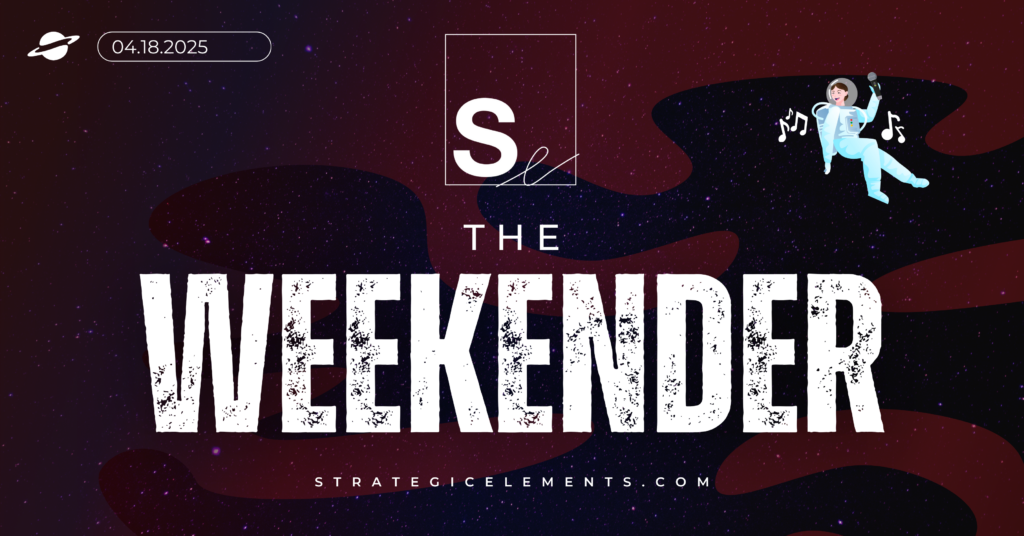DATA POINTS
- 11 Minutes – The length of the Blue Origins all-female suborbital space flight
- 17 – The number of times Rory McIlroy competed in the Masters before winning this year
- 43% – The percentage of shoppers that are open to switching to lower-cost brands for snacks and candy
- 60% – The percentage of Coachella attendees who purchased their general admission tickets on a payment plan
- 1.5 Million – The number of iPhones shipped out of India ahead of Trump’s imposed tariffs
- $23.6 Billion – The amount consumers have spent on Easter this year
Go for Gold
President Trump’s tariffs have shaken up the economy; now, they are shifting where investors put their money. Just like Olympians every four years, rare Earth gold metal is breaking its own record, trading at more than $3,200 an ounce – its highest price (inflation-adjusted) since 1980. Rather than playing odds in the stock market, more people are seeing gold investments as a safe money-maker.
This is not the first time gold has been considered a financial haven during uncertain times. The last time the element peaked in value was in 1980, when the Iranian revolution, the Soviet invasion of Afghanistan, and high inflation made people look twice at precious metals. The price of gold has also been steadily increasing since 2022 following U.S. sanctions on Russia as central banks began stockpiling it to reduce their reliance on the U.S. dollar.
Just as the rising price of gold does not exist in a vacuum, neither do its outcomes. Mining company stocks leaped upward, retail and consumer investments are up, and the Money Metals Exchange had its busiest days right after tariffs were announced.
If you’re looking to change your investment habits, the market has already bitten down and verified that gold is real.
Read More at The Washington Post
Women’s Sports Coverage is Going Mainstream
There’s a buzz building in sports media, and it’s powered by women. From USA Today launching Studio IX to Whoopi Goldberg backing an all-women’s sports network, coverage of women’s sports is going mainstream. And not just as a novelty, but as a powerhouse of viewership, advertising, and culture.
Between Caitlin Clark’s star power boosting WNBA viewership and the NCAA Women’s Final Four topping ratings charts, 2024 told media companies that this isn’t a niche, it’s a movement. According to EDO, ads during women’s sports were 40% more impactful than the average primetime spot. That’s not just meaningful, that’s market-shifting.
This shift isn’t top-down. Outlets like The GIST and Just Women’s Sports are changing the way fans engage with content. They’re proving that women’s sports aren’t “emerging,” they’re already here. Women’s sports aren’t just catching up; they’re setting the pace.
Stars Among the Stars
Blue Origins, founded by Amazon’s Jezz Bezos, always had one goal: to create a future where space is accessible to humankind. Its April 14 launch took the company to new heights as it took six women to the edge of the atmosphere. Singer Katy Perry, broadcast Journalist Gayle King, rocket scientist Aisha Bowe, and three others spent 11 minutes on the edge of space – becoming the first all-female crew in more than 60 years. The last all-female spaceflight was conducted on June 16, 1963, by the Soviet Union’s Valentina Tereshkova on her solo flight. With Blue Origins’ crew successfully landing back onto the Earth, the company has now sent 58 people toward the stars.
Don’t hold your breath for your ticket into the void, however. Tickets on the once-in-a-lifetime trip cost millions of dollars. Spacefaring rates are reserved for celebrities, entrepreneurs, renowned scientists, and a handful of lucky individuals winning their seats in contests. For those who can afford their spot, being strapped on the top of a tube orchestrating a series of controlled explosions sending them at supersonic speeds (over 2,000 MPH during ascent) upwards may be a bit too much to handle. Whether or not space travel becomes fully accessible still hangs in the air.
Mom and Dad, Inc.
As white-collar jobs become increasingly sparse for college graduates, more people are choosing to work for companies run by their parents. A cooling job market for entry-level positions makes the choice easier for many: keeping a career in the family allows grads to spend more time with family, garner valuable work experience, and feel a sense of responsibility and ownership for the work they are doing.
For many entrepreneurs who are feeling pressure to identify a line of succession while approaching retirement, this is a win-win. Entrusting what they’ve built to their children makes sense for many.
Read More at The Wall Street Journal
AI Anxiety
Those born in the age of the internet are cautious about AI and are pushing for clear policies regarding its implementation in the workplace. A survey of 3,500 13–28-year-olds living in the U.S. underscores their concerns. 49% said they believe AI will harm their critical thinking skills, and 41% said AI makes them anxious. Without clear regulations in work and school, those who wish to “follow the rules” often avoid AI altogether, offering an advantage to their peers who are willing to take advantage of the lack of guidance. On the other hand, young people do not ignore its value. 72% agree it can help them find information more easily, 66% said it helps them work faster, and 53% said it helps them learn faster.
See you next week!
Be sure to follow us on Facebook, Twitter, and LinkedIn for more news and industry updates. To receive a copy of The Weekender in your inbox, sign up here.










